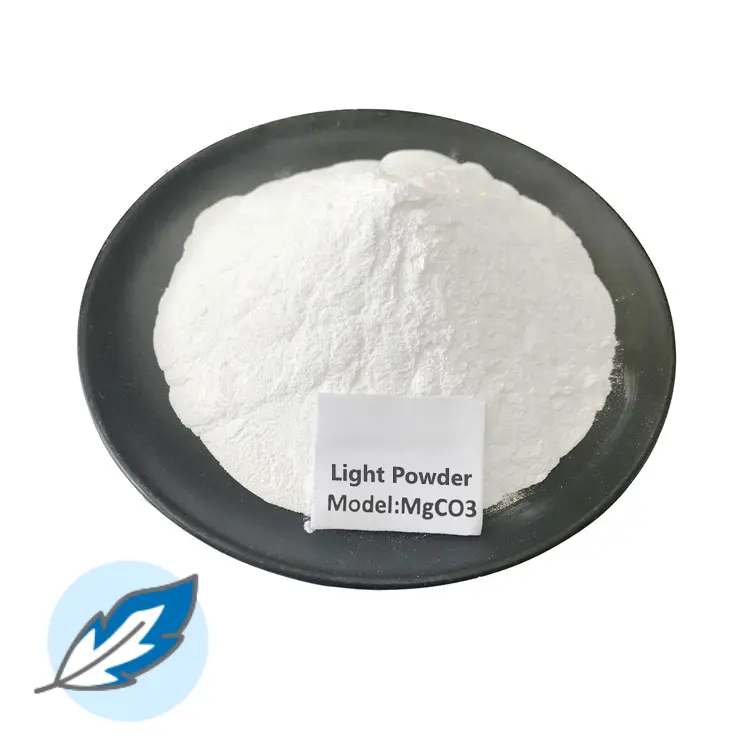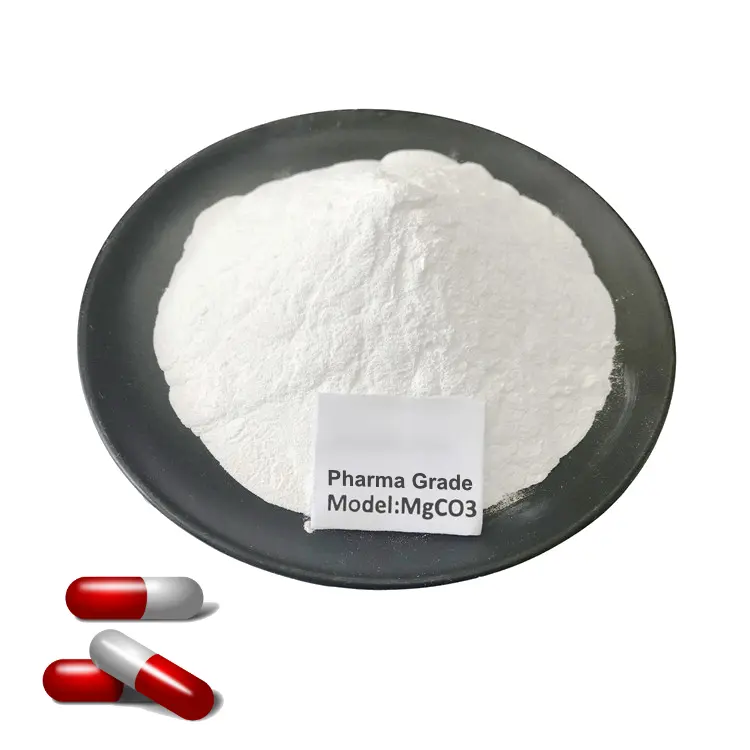Description
Preparation of high-purity magnesium carbonate by one-step iron removal method
Technical field
The invention relates to the field of inorganic salt chemistry and chemical engineering, and in particular to a new iron removal method for preparing high-purity magnesium carbonate.
Background technique
Basic magnesium carbonate is an important inorganic salt product with good filling and dispersibility, which can improve the tensile strength and wear resistance of rubber and plastic products. It is a good filler and reinforcing agent for rubber and plastic products. It can also be used as a filler in paints and coatings, toothpaste, cosmetics, medicine and other industries. With the rapid development of the national economy, the demand for high-quality magnesium carbonate is increasing year by year. Since the presence of iron and other metal impurities greatly affects the quality of magnesium carbonate, how to reduce the iron content is an important step in improving the quality of magnesium carbonate. Chemical iron removal methods have been reported in the literature at home and abroad. Currently, the most commonly used method is to add oxidants to remove iron in the form of Fe(OH)3 precipitation. However, Fe(OH)3 precipitation is slow and difficult to separate, which makes it difficult for practical applications. Production brings great inconvenience. Furthermore, a reducing agent must be added first to reduce the ferric iron to divalent iron, and then complexed with a complexing agent to achieve the purpose of iron removal. However, this method is costly and ineffective and is not conducive to large-scale industrial production.
Contents of the invention
The object of the present invention is to provide a method for removing iron in the process of preparing high-purity magnesium carbonate. This method obtains a high-purity magnesium carbonate product without changing the original production process, and the iron content in the obtained high-purity magnesium carbonate product is 0.004% (the national premium product standard is 0.02%).
The purpose of the present invention is achieved through the following technical solutions:
A one-step iron removal method is used to prepare high-purity magnesium carbonate. The steps are as follows:
(1) At room temperature, according to the iron content in the heavy magnesia water, add the reducing agent sodium dithionite (Na2S2O4) with a theoretical molar content of iron 1.2 to 1.5 times, and stir for 3 to 5 minutes while stirring to remove the ferric iron in the heavy magnesia water. Completely converted into ferrous iron;
(2) Take the above completely reacted heavy magnesium water, add sodium sulfide with 1.2 to 1.5 times the theoretical molar content of iron at room temperature, and stir evenly to obtain a black turbid liquid;
(3) The black turbid liquid is allowed to stand to completely precipitate ferrous sulfide, and the heavy magnesia clear liquid is separated. During the reaction, light-burned powder, that is, the product of calcined magnesite, may be added, and vacuum filtration is performed to obtain the heavy magnesia clear liquid.
The one-step iron removal method is used to prepare high-purity magnesium carbonate, which adds a main reducing agent insurance powder and a secondary reducing agent sodium sulfide.
The one-step iron removal method is used to prepare high-purity magnesium carbonate. The end point of the reduction reaction is detected with potassium thiocyanate solution. When ferric ions react with potassium thiocyanate, there will be a significant color change. If blood red appears, there will be no visible color change. When the reaction is complete, the reducing agent should be continued to be added until no ferric iron can be detected with potassium thiocyanide.
The advantages and effects of the present invention are:
1. There is no need to change the original production process, no need to build additional treatment facilities, low investment, and good iron removal effect. The iron content in the obtained high-purity magnesium carbonate product is about 0.004%, which exceeds the national premium product requirement of 0.02%. .
2. During the iron removal process, metals such as Mn2+ are also precipitated and removed in the form of sulfide along with ferrous sulfide, achieving the effect of killing two birds with one stone.
3. The reaction speed is fast, the operation is simple and convenient, the working conditions are good, and the cost is low. Calculated based on the current market price of drugs, the cost of producing iron removal per ton of magnesium carbonate products is 50 to 60 yuan.
The present invention is described in detail below:
At room temperature, according to the iron content in the heavy magnesia water, add the reducing agent sodium dithionite (Na2S2O4) with a theoretical molar content of iron of 1.2 to 1.5, and stir for 3 to 5 minutes at the same time to completely convert the ferric iron in the heavy magnesia water into dihydrogen. Price iron. The reaction end point is detected with potassium thiocyanate solution. The specific operation is: take 5 to 10 ml of the reduced solution, and add 2 to 3 drops of potassium thiocyanate solution. If blood red appears, the reaction is not complete, and the reducing agent should be continued to be added. Until no ferric iron can be detected using potassium thiocyanide. Take the above completely reacted heavy magnesium water, add sodium sulfide with a theoretical molar content of iron of 1.2 to 1.5 at room temperature, and stir evenly. A black turbid liquid was obtained. The black turbid liquid is allowed to stand to completely precipitate the ferrous sulfide, and the heavy magnesium water clear liquid is separated. (In this reaction step, a certain amount of light-burned powder (the product of calcined magnesite) can also be added, and the heavy magnesia water clear liquid can be obtained by vacuum filtration). According to the known method, heavy magnesium water is pyrolyzed, filtered and dried to obtain high-purity magnesium carbonate product.
The present invention is aimed at iron-containing heavy magnesium water (magnesium bicarbonate solution). The reducing agent sodium dithionite is added to reduce ferric iron to divalent iron, and then sodium sulfide is added to generate ferrous sulfide precipitation. After natural sedimentation, heavy magnesium water is obtained. The clear liquid is pyrolyzed, filtered and dried to obtain high-purity magnesium carbonate product. This method obtains a high-purity magnesium carbonate product without changing the original production process, and the iron content in the obtained high-purity magnesium carbonate product is 0.004% (the national premium product standard is 0.02%). There is no need to change the original production process, no need to build additional treatment facilities, low investment, and good iron removal effect. The iron content in the obtained high-purity magnesium carbonate product is about 0.004%, which exceeds the national premium product requirement of 0.02%. The reaction speed is fast, the operation is simple and convenient, the working conditions are good, and the cost is low. According to the current market price of drugs, the cost of producing iron removal per ton of magnesium carbonate products is 50 to 60 yuan. During the iron removal process, metals such as Mn2+ are also precipitated and removed in the form of sulfides along with ferrous sulfide, achieving the effect of killing two birds with one stone.
Example: Take 100ml of heavy magnesium water with an iron content of 0.19g/L, add 5ml of 0.1mol/L sodium dithionite and stir for two minutes, then add 5ml of 0.1mol/L sodium sulfide and stir to obtain a black turbid liquid, add 0.1 About gram of lightly burned powder was vacuum filtered to obtain a heavy magnesium aqueous solution, which was pyrolyzed and filtered at 95°C and dried to obtain a magnesium carbonate product. The iron content was detected to be 0.004%.



